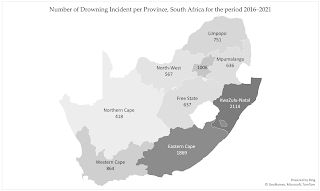A study conducted by the National Sea Rescue Institute (NSRI) indicates that it is an assumption that drownings occur frequently in the ocean, and an abundance of resources are deployed to prevent these drownings.
The NSRI briefed the media on Monday, ahead of the festive
season, to present its study of fatal drownings from 2016 – 2021. The data used
for the study were obtained from the South African Police Service.
In recent years, research into fatal drownings has
increased, highlighting fatal drownings as a serious public health concern.
Low- and middle-income countries have been referred to as
having the highest burden of global drownings. Approximately 90% of the annual
global drownings occur in LMICs. Furthermore, Africa has been reported to have the
highest drowning rates .
Varying reasons have been cited as contributing factors for
the high burden of fatal drownings in LMICs, which include, but are not limited
to, the lack of drowning prevention initiatives, the lack of regulations and policies
related to drowning prevention, insufficient water safety awareness and
education campaigns, and a lack of basic swimming skills
Dr. Cleeve Robertson NSRI CEO, says they will use the study
to better interventions
‘’An organisation like the NSRI, data like this is
fundamental to us launching interventions and prevention activities.
Understanding the drowning society is very important to design solutions to
prevention.’’
Dr. Jill Fortuin, Executive Director of Drowning Prevention
at NSRI said Fatal drowning incidents are prevalent in children in the age
group under 4, with 2 755 drowning incidents reported.
‘’This clearly confirms that this age group is a huge
concern. It has the highest drowning across all age groups. One child drowns
one day across
Fortuin says the data in the study is based on reported
fatal drownings, so it is possible the number of South African drownings could
be more.
‘’We only receive one set of drowning data, so there could
be situations were there was no body found or someone hasn’t reported a
drowning as it hasn’t occurred. Furthermore, this data gives us one
perspective. Things like where was the pre-event.
Furthermore, in the study, it was found that more males
drowned in South Africa compared to females. Males represent 81% of all the
drownings for the time period of the study.
The KwaZulu-Natal province has the most reported drownings,
with 2 114 drownings recorded from 2016 to 2021, followed by the Eastern Cape with
1 869, Gauteng has 1 006 reported drownings, and the Western Cape recorded 864
drownings in the 6 year-period.
‘’ During the month of January, the number of fatal
drownings was recorded as 1171, whereas February recorded 931 and November
recorded 882. Sundays were the day of the week when fatal drownings (n = 1591)
occurred more frequently, followed by Saturdays (n = 1503). Fatal drownings
have been most frequently reported as occurring between 16:00 and 19:59 (n =
2639),’’ said Dr. Jill Fortuin, Executive Director of Drowning Prevention at
NSRI.
The research findings highlight that fatal drownings are
most likely to occur in January and February; these months are the warmer
months in South Africa. Research has indicated that the drowning incidence was
higher in warmer months due to the increase in waterrelated activities [15].
The day of the week reported as the day when fatal drownings frequently occur
is Sunday, which is a recreational day when people can visit dams, beaches, swimming
pools, etc. With these results, adequate drowning prevention interventions can be
implemented. For example, increasing lifeguard coverage during the months of
January and February, especially on Sundays, with a focus on the time period
from 16:00 to 19:59,’’ she added.
The study revealed that the highest number of drownings occurred
in freshwater, with 3 713 drownings reported from 2016 to 2021
‘’ Fatal drownings occurred more frequently in
freshwater in South Africa during the 2016 to 2021 period. This is in keeping
with the findings of the epidemiology of drowning in other LMICs, which
indicates that drownings are common in small bodies of water, such as cisterns
and wells, as they are more commonly used than saltwater bodies,’’ said NSRI CEO
Dr. Cleeve Robertson
The message this festive season, says the NSRI, is to be
cautious.
“With the festive season upon us, we are urging extreme
caution to South Africans who will be making their way to the coast to not
drink and swim, supervise children in and around the water and ensure that you
know the emergency number,” said Dr. Jill Fortuin, Executive Director of
Drowning Prevention at NSRI.
Compiled by: Mitchum George


Comments